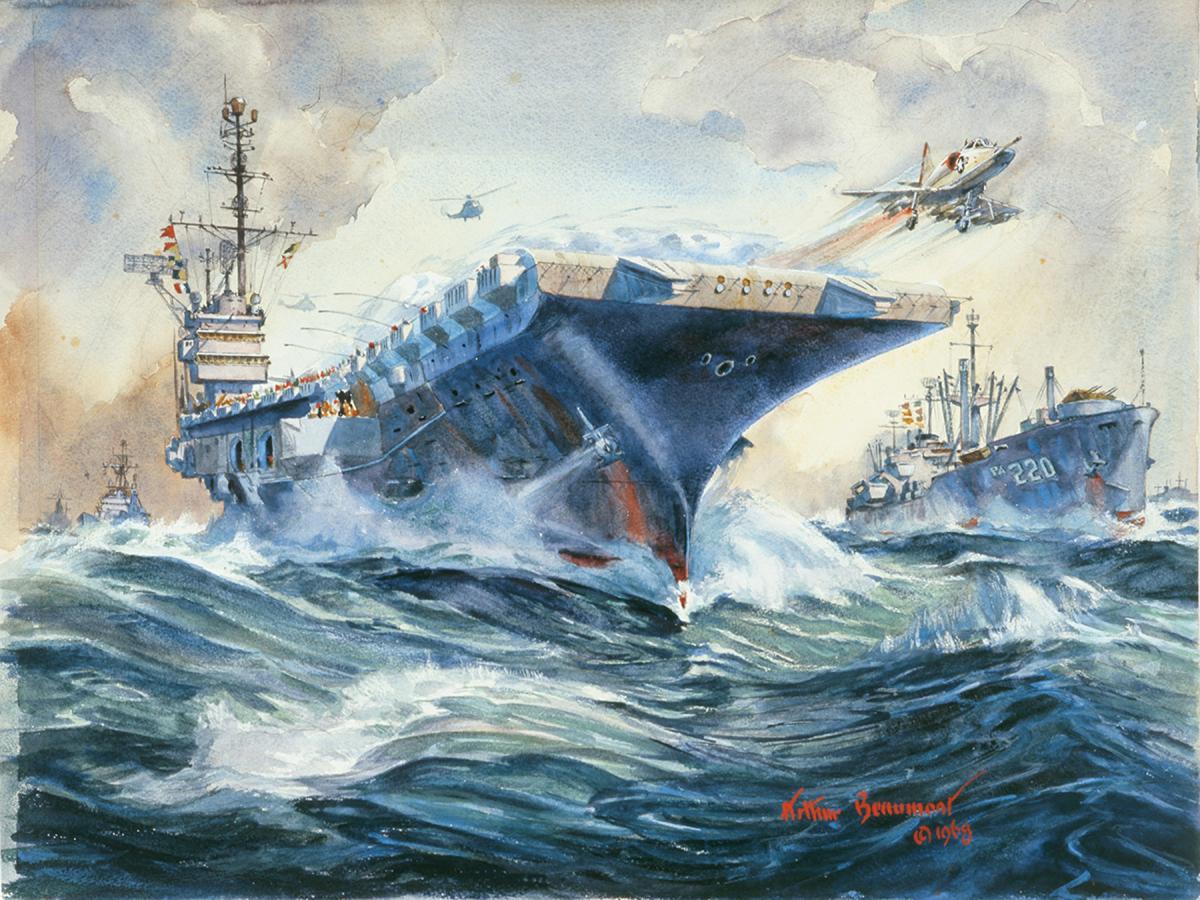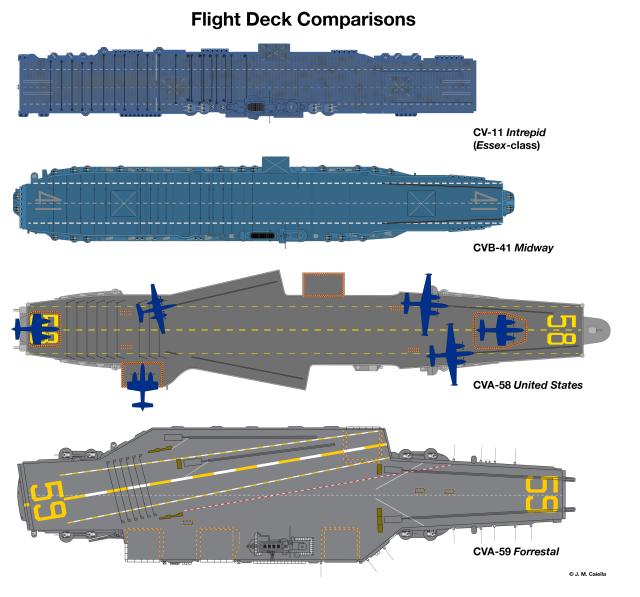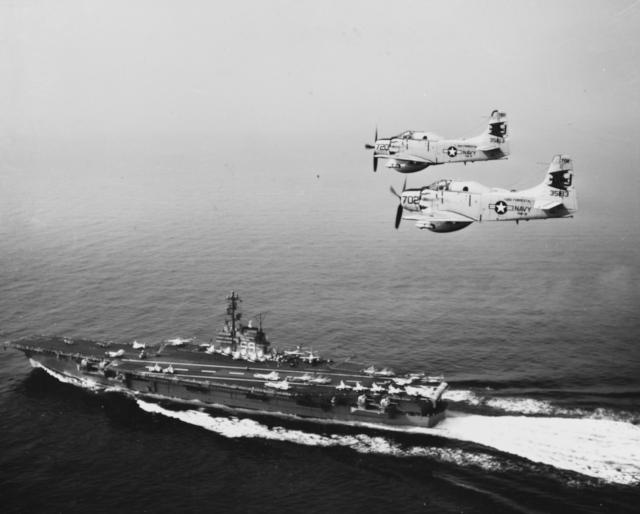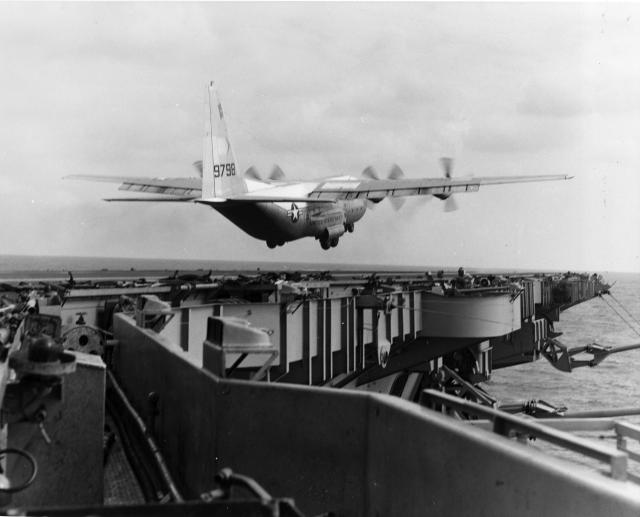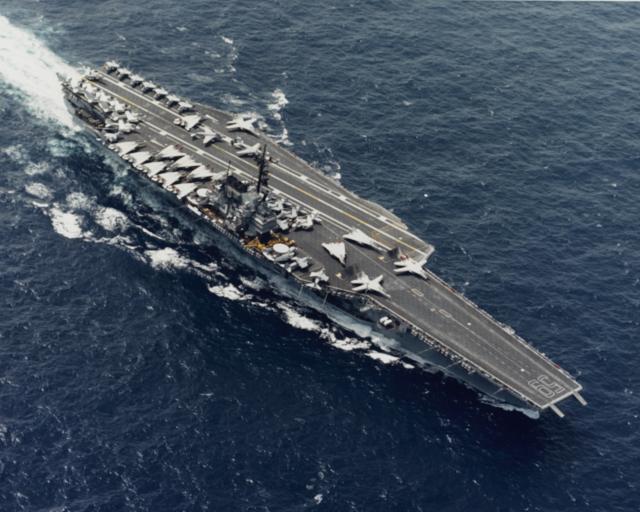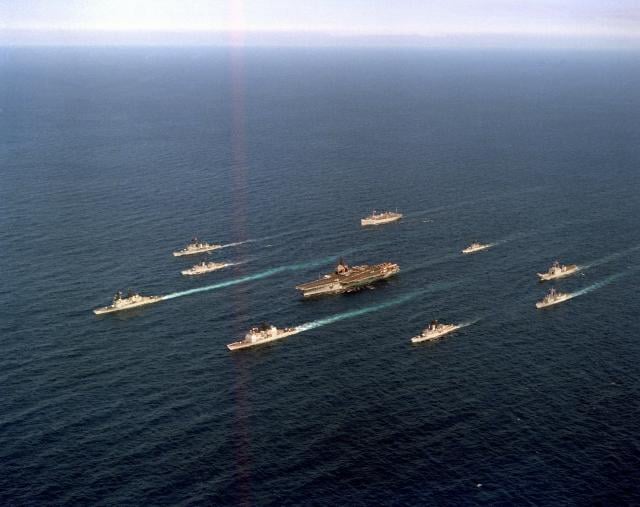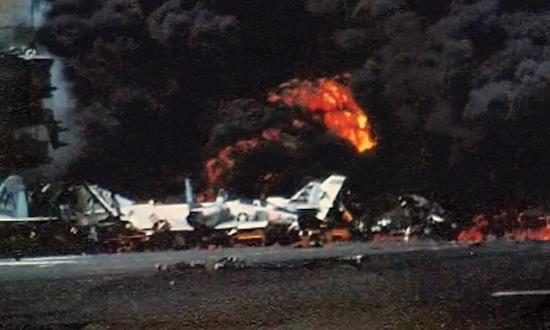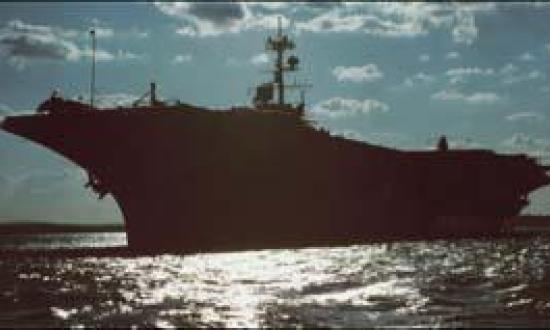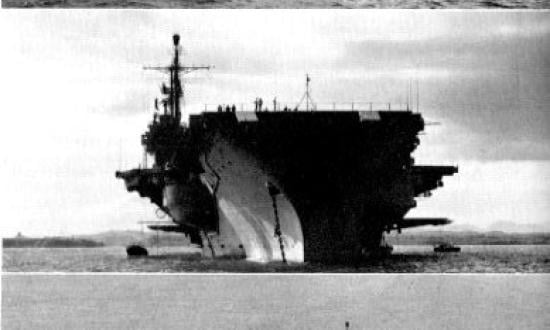When the USS Kitty Hawk (CV-63) and John F. Kennedy (CV-67) were sold to a shipbreaker for one cent each in 2021, the era of the conventionally powered big-deck aircraft carrier was over. Arguably, that period began on 14 July 1952, when the keel of the USS Forrestal (CV-59) was laid down at Newport News Shipbuilding. Spanning 54 years from Forrestal’s commissioning, the service of the eight big-deck conventionally powered carriers ended on 12 May 2009, when the Kitty Hawk was decommissioned. For more than half a century, the ships each represented 4.25 acres—give or take a few decimals—of sovereign U.S. territory virtually anywhere on the world’s seas where and when the nation needed them.
When North Korea invaded South Korea on 25 June 1950, the United States was wholly unprepared. South Korea had not been included in Secretary of State Dean Acheson’s January 1950 strategic Asian Defense Perimeter speech that outlined U.S. foreign policy in Asia. Further, the United States military had severely drawn down since the end of World War II. The Navy’s 6,700-ship and 3.5-million-man 1945 force was reduced to 634 ships—19 of them aircraft carriers—and barely a half million sailors in 1950. Nevertheless, just two days after the invasion President Harry S. Truman ordered the Navy and Air Force in the Far East to support South Korean forces operations, as well as the Seventh Fleet to protect Formosa (present-day Taiwan).
On 1 July, the Navy formed Task Force Yoke from West Coast– and Pearl Harbor–based ships for the Korean campaign with orders to commence operations on the 3rd. On that date, the Navy flew its first carrier operations off the west coast of Korea from the Valley Forge (CV-45), at that time the only U.S. carrier in the western Pacific. Through to the signing of the armistice on 27 July 1953, Navy carrier-based aircraft prosecuted the war from around the perimeter of the Korean peninsula.
Early in the war, a classified Pacific Fleet Interim Evaluation Report unsubtly had included points in the continuing Navy–Air Force conflict (see “Historic Ships”). “The Korean War constituted in effect an almost perfect laboratory for the test of exploitation of both sea and air power as they currently exist.” This laboratory produced a series of ships, organizations, and training that evolved into today’s aircraft carrier strike groups of which the big-deck carrier is the centerpiece.
In August 1949, barely four months after the cancellation of the United States (CVA-58), the Navy began studies for a Midway-class size, flush-deck carrier to operate a newly notional 70,000-pound attack bomber, the Douglas A3D Skywarrior, in lieu of a 100,000-pound aircraft proposed earlier. Despite the cancellation of CVA-58 during the time’s austere climate, there was still much support in the halls of Congress for a big-deck carrier. Georgia Representative Carl Vinson, the Navy’s strongest advocate in the House of Representatives, suggested a 60,000-ton ship; this became the design goal.
On 11 July 1950, barely two weeks into the Korean War, Secretary of Defense Louis A. Johnson—the man who had killed the United States—offered Chief of Naval Operations Admiral Forrest P. Sherman a new carrier. It was written into the revised Fiscal Year 1952 budget program as SCB (Ship Characteristics Board) 80 and approved by Secretary of the Navy Francis P. Matthews on 30 October 1950.
Over the period from 1946 to 1950, the Navy’s view of carrier operations changed from one of strategic strikes by a small number of heavy bombers to a vision of tactical strikes by a larger air group of smaller aircraft. By 1950, it was also apparent that the size of nuclear weapons was rapidly shrinking, and that soon, fighter-size aircraft would be able to carry them. To that end, the Bureau of Aeronautics (BuAer) issued requirements for what became the diminutive Douglas A4 Skyhawk. Further, the invasion of South Korea highlighted and reinforced the need for a U.S. quick-response team with significant tactical air-power capabilities. The open seas required neither basing permissions nor rights of overflight. The aircraft carrier is uniquely suited to the requirements.
The Navy wasted no time in getting the ship’s construction under way. The Bureau of Ships (BuShips) wanted three design studies completed by 15 February 1951 so that one could be approved by 1 March. The preliminary design for a the new CVB (Aircraft Carrier, Large) was to be ready six months later, on 1 September, for contract negotiations to begin on 1 December and the contract to be let on 1 January 1952. The ship was expected to be completed exactly four years later, but with expeditious work, perhaps in three and a half years. In October 1952, the ship classification was changed to CVA, with the “A” designating attack—its mission rather than size.
The contract was let on 12 July 1951, and the Forrestal (CVA-59) was commissioned on 1 October 1955. The process, however, was not without issues.
Compromises to the Design
The Navy had chosen not to use specific characteristics for the new ship but instead had relied on those of the United States and an abortive 1945 fleet carrier as starting points. The ship’s original concept consisted of a flush armored deck with four catapults: two at the bow and two lesser capacity “fighter” catapults in the waist slightly angled off the centerline at both port and starboard. They were to be serviced by four elevators: two starboard fore and aft, one port amidships, and one at the stern. Her hull would incorporate a cruiser stern and twin skegs for two of her screws, reminiscent of those of the South Dakota–class battleships. All these features closely paralleled those of the aborted carrier. Where the canceled carrier appeared to use the British angled-deck concept by including such structures both port and starboard, it was the idea in name only. They would be used solely for the simultaneous launching of aircraft. The United States remained a straight-deck carrier at heart; the angles did not include landing capability. Initially, the Forrestal was as well.
(© J. M. Caiella)
The Forrestal was the world’s first carrier specifically designed and built to operate jet aircraft. The aviation component wanted a ship for all-weather operation, for which a closed bow was imperative to keep both hangar and flight deck drier. It was calculated that the new carrier would be able to operate 345 days of the year in adverse sea conditions compared with 220 days for an Essex-class ship. While the Navy General Board believed the enclosed bow to be an unnecessary restriction on the ship’s design, it had the positive effect of providing longer flight and hangar decks on a 60,000-ton displacement ship.
Catapults presented another problem. With the demise of the 100,000-pound bomber concept, the service was ready to accept catapults that could accommodate the new “normal” 70,000-pound aircraft. The United States had been designed to use four hydraulic catapults, which were very heavy, complex, and space-consuming devices. The Navy had been researching a “slotted-tube” variant, which eschewed cables and pulleys for a direct-acting mechanism. A power charge would impel a piston with the attached aircraft shuttle down a slotted tube. The device promised to be compact, simple, and space efficient; however, it was a failure. At about the same time, in 1950, the British experimented with a different slotted-tube concept on board HMS Perseus. Powered by steam rather than explosives, the British-designed catapult proved very successful, and the Forrestal would carry four of them.
Virtually every design parameter had to be balanced by others. Aviation fuel capacity was an unknown. Early jet aircraft were notoriously thirsty, and there was little operational information on which to base their needs. Based on their World War II experiences, aviators called for 750,000 gallons. The Forrestal would carry 1.5 million gallons. There was a trade-off; the heavier jet fuel was less volatile and did not require the armor protection that avgas for the World War II piston-engine aircraft did. Later, some of the carriers had their boilers modified to burn the jets’ JP-5 fuel, thus the ships’ endurance could be traded for more aircraft sorties.
Armor was another issue. The Bureau of Ordnance argued for a high level of protection, but this was tempered by the physics of weight high above the center of buoyancy. This was compounded by the height of the hangar deck. Among the Forrestal’s early characteristics was a hangar deck height of 19 feet. But the largest aircraft designed to be flown from the new ship, the A3D, required at least 22 feet. The design was revised for a height of 25 feet. This pushed all the weight of the flight deck up an additional six feet, which in turn killed any thought of additional deck protection while at the same time forced an increase in beam for stability. The deck was limited to 1.75 inches of steel plating.
From Flush Deck to Angled Deck
While the aviation community continued to press for a flush deck, the realities of the ship’s command and control moved the design in the other direction. As late as June 1951, while still a flush-deck design, the carrier featured elements such as piping, wiring, and ventilation that quickly could be modified into a permanent above-deck island structure. “After completion and evaluation,” it was decided to incorporate one. Boiler uptakes and need for various radar installations further complicated the flush-deck scenario. The hull was also redesigned eliminating the skegs for conventional screw placement and replacing the cruiser stern with a transom configuration.
Historian and analyst Norman Friedman declared, “The greatest change was the shift from that flush deck to the modern angled deck, which at a stroke solved most of the problems of the design.” The incorporation of the angled deck, developed by Royal Navy Captain Dennis Cambell in 1950–51, allowed carriers to conduct simultaneous launch and recovery operations. The revised deck provided a significant safety margin by allowing landing aircraft with clear space to accelerate and relaunch after failing to hook a landing cable. It also allowed the removal of several arresting gear deck pendants and their heavy mechanisms below deck. Beginning in June 1954, 14 Essex-class carriers were modified with angled decks, as were the three Midway-class ships.
In January 1953, BuShips recommended the 1955-authorization carrier have an angled deck and fixed island. This meant the first three ships of the Forrestal class already authorized would be obsolete. On 4 May 1953, Chief of Naval Operations (CNO) Admiral William M. Fechteler directed that all three ships were to have both. Still, BuShips prepared angled deck designs both with and without an island. One more revision, the 34th for the project, based on the CNO’s directive was submitted to Newport News in October.
The incorporation of an angled deck off to port into the Forrestal design obviated any envisioned need for a flush deck. The landing area was remote and directed away from the starboard side such that a structure there would present no safety issue. As built, the island’s centerline was nearly 95 feet to starboard from that of the ship and even farther from the angled deck. Additionally, the island solved the uptake issues by incorporating them into the structure and radar installations could be readily mounted without hindrance to air operations. A further benefit was that the antenna and radar placement high on the island gained greater electronic efficiency.
The final design had the Forrestal emerge with four deck-edge elevators—three to starboard and one port—that serviced the hangar deck, which was divided into three bays separated by fireproof doors. The starboard elevators were arranged with one forward of the mid-ship island, and two aft. The port elevator was at the forward end of the 10.5-degree angled deck. The forward starboard elevator served the two bow catapults during combined launch and recovery periods, while the port elevator was useless during these times.
The catapults, originally to be of the slotted-tube powder-powered design, were replaced by steam-powered units, two heavy C-7s at the bow and a pair of lighter C-11s at the waist. The removal and repositioning of the starboard waist catapult was the primary design issue adversely affected by the angled deck. The catapult was moved to the port side near and at an angle to the original. This prevented the simultaneous launch from both; however, aircraft could still be spotted at each at the same time.
In addition to the massive sponsons supporting the port deck overhang and the deck below the island, the ship had four additional large sponsons at the quarters, each supporting a pair of 5-inch, 54-caliber antiaircraft guns. In service, the forward sponsons proved very problematical during heavy weather by producing prodigious amounts of spray that forced the ship to reduce speed. Throughout their careers the Forrestals gradually would have the fore sponsons and gun mounts removed.
The island, 108 feet long by 17 feet wide at the flight deck level, rose seven levels to more than 118 feet above the waterline. Masts, antennas, and radars extended higher. It stepped two masts, the fore reaching 187 feet above the water line. That was 60 feet too high to clear the Brooklyn Bridge, which at the time was a Navy necessity to gain access to the New York (Brooklyn) Navy Yard; therefore, both masts were hinged to fold to port for clearance.
Despite the continual last-minute revisions, the ship was completed ahead of schedule. All that remained was proof of concept.
The Carrier’s Air Component
The Forrestal, the world's first supercarrier, spent the first year of her commission in intensive training operations from her homeport of Norfolk, Virginia. These were primarily conducted off the Virginia Capes and in the Caribbean. An important duty was training aviators in the ship’s revolutionary facilities and enhanced operational capabilities. For these, she used Mayport, Florida, as a base.
As the first of her type, she was witness to many milestones. Among the most significant occurred on 3 January 1956 when a North American FJ-3 Fury of Fighting Squadron (VF) 21 piloted by Commander Ralph L. Werner made the first arrested landing on board the Forrestal. A few hours later, he made the first catapult launch from the carrier. Werner commanded Air Task Group (ATG) 181, the first aviation group to be assigned to the ship. Commander W. M. Harnish, VF-21 commanding officer, followed him on board in a second Fury. An interesting note attached to the Navy-released photographs of the events stated, “Both aircraft were painted with the new white and grey ‘atomic’ paint scheme.”
These were not the first aircraft on board the ship, however. On 25 October 1955, three weeks after her commissioning, Lieutenant Commander J. E. Johnson made the first landing on board the Forrestal when he piloted a Piasecki HUP-2 Retriever helicopter of Helicopter Utility Squadron (HU) 2, Det. N.
The rest of ATG-181 landed on board in January. It included nine squadrons and detachments, each operating dissimilar aircraft. The air group served to break in the new carrier during her shakedown cruise from 24 January through 28 March 1956 in the Caribbean operating primarily off Guantanamo Bay, Cuba. Her final acceptance trials were run off the Virginia Capes from 23 to 27 April.
|
Air Task Group (ATG) 181 Composition Aboard Forrestal (CVA-59) January–March 1956 |
||||
|
Squadron Type |
Squadron |
Aircraft |
||
|
|
|
Manufacturer |
Designation |
Name |
|
Fighter |
VF-41 |
McDonnell |
F2H-3 |
Banshee |
|
|
VF-21 |
North American |
FJ-3 |
Fury |
|
Attack |
VA-86 |
Vought |
F7U-3M |
Cutlass |
|
|
VA-42 |
Douglas |
AD-6 |
Skyraider |
|
Heavy Attack |
VAH-7, Det. 42 |
North American |
AJ-2 |
Savage |
|
Composite |
VC-12, Det. 42 |
Douglas |
AD-5W |
Skyraider |
|
|
VC-33, Det. 42 |
Douglas |
AD-5N |
Skyraider |
|
|
VC-62 Det. 42 |
McDonnell |
F2H-2P |
Banshee |
|
Helicopter Utility |
HU-2, Det. 42 |
Piasecki |
HUP-2 |
Retriever |
After having her propeller shafts replaced beginning in May, the Forrestal was soon put on her first war footing with Carrier Air Group (CVG) 1. In response to heightened tensions in the Middle East during the Suez Crisis from 29 October to 7 November 1956, the United States joined with other United Nations forces to put pressure on the warring factions. U.S. Navy ships were directed to put to sea and rendezvous at specific points in preparation for possible action. By 17 November, the Forrestal was the flagship for one such concentration in the eastern Atlantic near the Azores. She remained on station until 12 December when she returned to Norfolk to prepare for her first deployment, with the Sixth Fleet in the Mediterranean Sea.
Her Early Deployments
This deployment, from 15 January to 22 July 1957 also with CVG-1, included three days in April off Beirut, Lebanon. Barely two weeks later, a coup attempt in Jordan heightened tensions in the region once again. Vice Admiral Charles R. Brown, Sixth Fleet commander, stated in an “all hands” message to the fleet, “Once again we find ourselves dropping everything and rushing to the scene of the fire.” On 26 April, the Forrestal rushed east and stood by as diplomats defused the situation. Within ten days, she was back on station off Italy ready for a NATO exercise. Admiral Brown noted that the crew should not lose sight of the “larger significance” of the event. “The distance between the two assignments is about 1,500 miles. . . . This performance has been a dramatic demonstration of the mobility and flexibility of the fleet.”
On her return to Norfolk, the ship went to the Norfolk Naval Shipyard (NNS) in Portsmouth, Virginia, for maintenance before her next deployment from early September to 22 October for Operation Strikeback, a NATO exercise in the North Sea. She then returned to Norfolk for two months of maintenance. After a series of major exercises off the East Coast for three months in early 1958 in which she embarked VA-72 and the A4D Skyhawk for the first time, she sailed to support activity during the Lebanon Crisis from 11 July to 17 August. She deployed to the eastern Atlantic with CVG-10, which marked her first embarkation with Douglas F4D-1 Skyrays and Vought F8U-1 Crusaders of VF-102 and VF-103, respectively.
She began her second major cruise to the Mediterranean (Med) on 2 September 1958, which was unremarkable except for the separate failures of her two bow catapults. Her crew and civilian workers made extensive repairs to both at Naples, Italy. This was the first time such work was accomplished outside of a shipyard. The cruise ended on 12 March 1959.
From 1 April through the end of August, she entered NNS for her first regular overhaul. On 28 January 1960, after two exercises off the East Coast and a hurricane evasion sortie, the Forrestal once again set sail for the Mediterranean this time with CVG-8. This cruise proved more uneventful than the previous one. The sole exception was a port visit at Split, Yugoslavia, which caused some press controversy regarding the Yugoslav communists and the West. After returning to Norfolk on 31 August, she once again entered the shipyard for nearly two months of maintenance and repairs.
(Naval History and Heritage Command)
On 9 February 1961, the carrier sailed for her fourth Med cruise, which was completed on 25 August. During that period CVG-8 amassed 26,000 flight hours—nearly three years of flying time during less intensive operations. The 60,000th arrested landing was also marked. Another yard period, this of four and a half months, followed, which was significant. During this, her forward 5-inch guns, their directors, and, more important, their sponsons were removed. The bulbous sponsons were severely pounded in heavy seas, forcing the ship to reduce speed. The loss of the guns was of little concern because their effectiveness against modern aircraft was doubtful. The ship also had her arresting gear reduced from six to four wires, and she added the Fresnel lens landing system—the now familiar “meatball” mirror system—and the large SPS-43A air search radar was mounted on the starboard side of the island.
After a six-week workup in the Caribbean, on 14 April 1962, the Forrestal participated with the five-month-old Enterprise (CVA[N]-65) in an air-power demonstration for President John F. Kennedy, the Joint Chiefs of Staff, U.S. senators and representatives, and about 30 ambassadors.
Over the course of the next five years, the Forrestal made three more Mediterranean cruises, each with CVW-8 embarked. On the fifth cruise, from 3 August 1962 to 2 March 1963, her aircraft flew more than 10,300 sorties and accumulated more than 23,000 hours of flight time. The highlight of the sixth, from 10 July 1964 to 13 March 1965, was her 100,000th landing. The seventh had its share of excitement. After departing Norfolk on 24 August 1965, the carrier responded to the crash of a U.S. Air Force Douglas C-47 Dakota in the Greek mountains on 14 January 1966. Two helicopters from the ship’s Helicopter Support Squadron (HC) 2, Det. 59, flew the search-and-rescue mission. After multiple flights battling high turbulent winds and with no clear landing areas, they retrieved survivors and bodies to a base camp. Because UHF communications was impossible from their location, the helicopter crews relied on radio relay help from one of Forrestal’s Grumman E-1B Tracer from Carrier Airborne Early Warning Squadron (VAW) 12. On 2 February, one of the ship’s McDonnell F-4B Phantom IIs of VF-74 crashed three miles from the ship. Both crew members safely ejected and were picked up by one of the carrier’s UH-2A helicopters. By the time the Forrestal completed the cruise on 7 April 1966, more than 11,000 sorties over 19,000 flight hours had been logged.
After this, the ship entered NNS for an overhaul, which included the widening of the final 120 feet of the angled deck by 15 feet to accommodate the longer run-out of newly installed arresting gear.
(Naval History and Heritage Command)
Between her fifth and sixth trips to the Mediterranean, the ship and her crew were involved in three very interesting days of experiments. Over the course of 30 October and 21–22 November 1963, a very slightly modified Lockheed KC-130F Hercules four-engine heavy transport aircraft completed 29 touch-and-go landings and 21 full-stop landings and subsequent takeoffs. The huge aircraft—its wingspan was 132 feet, 7 inches, compared with the then-largest carrier-borne plane, the A3D with a span of 72 feet, 6 inches—was on loan to the Naval Air Test Center at Naval Air Station Patuxent River, Maryland, by Naval Air Transport Squadron (VR) 3. The slight modifications included a change of antiskid braking systems from the standard C-130 type to one used by commercial Boeing 727 airliners and removal of wing refueling pods. The crew painted a white centerline down the full length of the axial deck to guide the pilots. On its first landing, on the 30th, the plane’s wingtip cleared the island by less than 15 feet. The Hercules remains the largest and heaviest aircraft to land on an aircraft carrier. The Navy determined that the type could carry 25,000 pounds of cargo and personnel 2,500 miles with a gross weight of 121,000 pounds and safely land aboard a Forrestal-class or larger carrier. It also concluded that it was too risky to use the big planes for routine carrier on-board delivery flights.
After her return from her seventh cruise, the carrier began a nine-month overhaul at the Norfolk Navy Yard. The most significant new addition was that of the Naval Tactical Data System (NTDS), which became the principal instrument of her combat information center. She completed her post-overhaul trials in early January 1967 and moved to Guantanamo Bay for refresher training and a series of exercises to prepare her for her forthcoming cruise—to the western Pacific and Vietnam. For these she had embarked a new air wing, CVW-17.
Forrestal Catastrophe at Yankee Station
Repairs and Back in Service
On 19 September, after her return to Norfolk following the disastrous fire, the Forrestal was moved a short distance up the Elizabeth River to the Norfolk Naval Shipyard to begin nearly five months of extensive repairs. Before she could enter dry dock, her No. 4 (starboard aft) elevator had to be removed. The 115-ton elevator had been jammed in the down position since the fire.
Two days later, after a thorough search of the ship in the wake of a bomb threat, she entered Drydock No. 8. By 22 September, she was resting dry on keel blocks in the dry dock. The four aft 5-inch gun mounts were removed, and their sponsons received modifications for antiaircraft weapons to be mounted later.
Some 175 feet of the aft flight deck was removed and replaced along with about 200 compartments on six decks. Among the larger repairs were to the jet engine repair shop and test stand, the ship’s post office, and the parachute loft. The ship’s port rudder, which had received bomb shrapnel damage, was repaired, as was its fire-damaged steering room.
Work on the hull was completed on 9 February 1968, and the ship floated free of the dry dock the next day after 142 days. Dock trials began on 4 March, and on 8 April—after nearly five months and about $72 million (more than $601 million in 2022 dollars) in repair costs—the Forrestal was once again under her own power and moving out to sea for post-repair trials. These extended through 15 April and included the first post-fire arrested landing.
For the next three months, the carrier regained her air wing, once again CVW-17, and conducted qualifications and refresher trainings and pre-deployment exercises in the Caribbean and off Jacksonville, Florida. Issues with a steam turbine forced an early end of training on 1 July, when she reentered NNS for its repairs through the 20 July.
Beginning two days later, the Forrestal would begin a series of ten cruises all to the Mediterranean with CVW-17 embarked that culminated at the end of 1982. In January 1983, she entered the Philadelphia Naval Shipyard in Pennsylvania to begin a 28-month, $694 million Service Life Extension Program (SLEP) project designed to extend her service life by 15 to 20 years.
A ‘Typical’ Cruise
A look at just one of those pre-SLEP deployments serves as a boilerplate template for the others. While in no way identical, each had parallels to the ship’s 14th Med cruise from 4 April to 26 October 1978. Invisible to those who have never experienced a “cruise” is the intensive organizational and operational coordination that spans the entire period of the assignment. Within that span are 24/7 workweeks broken only by periods of intense focus as emergencies crop up and relieved only by brief port calls.
While en route from Norfolk to Gibraltar, the crew responded to two fires three days apart. The first broke out in a machinery room just two days out of port. The second was in a catapult steam trunk. Both were quickly put down with minimal damage that did not affect operations. For ten days from 19 April, the carrier conducted antisubmarine warfare training exercises in the western Mediterranean and Tyrrhenian Sea in a program called “ASW Week.” During this period, one of the ship’s F-4 Phantom IIs of VF-74 completed the ship’s 227,000th arrested landing. On the same day, the 21st, one of the Forrestal’s escorts obtained a sonar contact on a possible submarine. One of the carrier’s Sea Kings picked up an active contact and prepared for a torpedo drop. A second helicopter verified the contact and tracked the submarine as it maneuvered to escape the contacts. This was the first of several similar contacts made during the carrier’s deployment.
On the last day of the exercise, a Grumman KA-6D Intruder tanker from VA-85 crashed, but a pair of the carrier’s helicopters rescued its crew of two.
After the Forrestal made a port call at Naples from 30 April to 8 May, she began nine days of antiair-warfare exercises beginning on the 9th in the eastern sea north of Crete and in the Ionian Sea. On the second day of the exercise, a pump room flooded to a height of 20 feet before the problem was controlled. Flooding spread to adjacent food storage rooms and destroyed most of the ship’s stock of fresh milk and produce. Damage was estimated at $30,000; however, once again, operations were not affected.
The day after the antiair exercises ended, on 19 May, the ship segued into “Dawn Patrol,” a combined NATO exercise that spanned the central and eastern Mediterranean. This ten-day exercise included more than 80 ships and submarines from the United States, Great Britain, France, Greece, Italy, and Turkey. The carrier visited Catania, Sicily, from 30 May to 5 June before steaming to Marseilles, France, for minor-repair maintenance from 7–22 June. Armored covers over external jet fuel pipes on the hull were replaced, structural repairs to the flight deck were made, and 15 watertight doors were repaired.
From the shipyard on the 22nd, the Forrestal entered five days of antisubmarine and mine warfare exercises in the western Mediterranean and Ionian Seas. On 24 June, the air wing operations officer was killed when his Vought A-7E Corsair II crashed two miles off the southern coast of Sicily. The next day, another A-7E crashed shortly after launch from the ship. That pilot survived and was recovered.
The carrier led a six-ship task group during the sea-control exercise “Tridente” from 5–11 July in the eastern Mediterranean and northern Ionian Seas. Warships from Great Britain, France, Germany, Greece, and Italy participated. Two weeks later, from 23–31 July, the Forrestal worked with more NATO units during “National Week XXV” sea-control, power-projection, and antisubmarine-warfare drills. This was followed by two weeks at Valencia, Spain, where more than 30,000 visitors toured the ship.
The next week, 15–23 August, involved training exercises in the western Mediterranean. On the 17th, an F-4J of VF-74 crashed 60 miles from the ship, but a helicopter from the carrier rescued its crew of two. On the 21st, the ship’s company responded to a fire in a storeroom, which they controlled within 10 minutes. The next day, the ship’s air wing flew an air-defense exercise against French Air Force aircraft.
After a four-day stop at Palma in the Balearic Islands, the Forrestal left the Mediterranean bound for the North and Norwegian seas to take part in “Northern Wedding” (4–18 September). The massive NATO exercise involved more than 40,000 personnel, 22 submarines, and 800 aircraft from nine NATO members. The exercise, normally held every four years, tests the organization’s resistance ability to reinforce Western Europe in the face of an Eastern Bloc attack. The Forrestal and HMS Ark Royal each led a task group and operated closely to deploy their aircraft in support of amphibious operations in the Shetland Islands and around the Jutland Peninsula.
From 18 to 28 September, the Forrestal transited back to the Mediterranean to participate in ten days of “Display Determination,” an exercise involving the southern region of NATO. Eight members of the alliance practiced rapid reinforcement and resupply of Europe’s southern flank through 8 October. Two days after the operation, during a night refueling of the carrier by the fast combat support ship Detroit (AOE-4), one of her crewmen fell overboard. A Forrestal helicopter plucked him from the ocean.
After clearing Gibraltar on 15 October bound for home, the carrier steamed to the far north to participate in “Operation Windbreak,” a program to introduce sailors to—and allow them to exercise their equipment in—unfamiliar waters and conditions. The Forrestal ranged to 150 miles south of Iceland and experienced 34-foot seas and 70-knot winds. There was a more subtle reason for the exercise: It was to gauge Soviet monitoring of U.S. ships steaming to and from the Mediterranean. The ship arrived at Mayport Naval Station, Florida, on 26 October.
Other Cruise Highlights
On her eighth Med cruise, the first since the fire, an A-4C of VA-34 had completed the ship’s 130,000th trap off Marseilles, France. The nine-month deployment was her longest to date. The next cruise was marked by an RA-5C of RVAH-13 making the ship’s 150,000th trap. Over five days from 16 June 1970, the carrier patrolled the eastern Mediterranean in support of a possible evacuation of Americans from Jordan because of civil unrest there. Her tenth cruise was more eventful. On 7 February 1971, four of her SH-3D helicopters from HS-3 rescued 20 crew members and passengers from the sinking ore ship Flamingo off southern Italy. During NATO’s “Operation Dawn Patrol” on 2 May, an F-4B of VF-11 made a barrier landing after losing a landing gear on an earlier missed approach. After this cruise, the Forrestal entered the shipyard for more work, which included two new jet blast deflectors that enabled her to operate the Grumman F-14A Tomcat with which she trained for the first time from 16 to 28 June1972.
Before her next cruise, the carrier once again suffered a significant fire. On 10 July 1972, while moored at Norfolk, a crew member deliberately started a fire in a computer room just below the flight deck. The deck was cut open, and hundreds of gallons of water were pumped into the space, causing a significant list and loss of all the computer equipment. The cost was estimated at more than $7 million. The ship moved to NNS for three months of repairs, which forced the John F. Kennedy (CVA-67) to extend her deployment.
The Forrestal’s 11th cruise displayed the Navy’s reaction to humanitarian crises. On 22 October 1972, an Olympic Airways airliner crashed after takeoff from Athens, Greece. Four of the carrier’s Sea King helicopters of HS-3 participated in night search-and-rescue operations and assisted in rescuing 19 passengers and crew members. From 28 to 31 March 1973, the carrier led two other Sixth Fleet warships to Tunis to assist flood victims. Her helicopters flew 40 sorties and rescued 200 victims while also delivering four tons of supplies. The ship’s bakery provided 1,200 loaves of bread for distribution, while her company contributed funds to homeless children. Several of the carrier’s air traffic controllers were detached to the Tunis Airfield, where they helped direct air operations from the control tower. During this cruise, her aircraft flew 13,731 sorties over 28,355 flight hours.
On her return, the Forrestal began a three-month overhaul at NNS on 2 August 1973, which through the collective efforts of shipyard workers and crew members working at “fever pitch” 24/7 for a month reduced the stay by two months. The impetus was the Yom Kippur War in the Middle East. During workups for her next deployment, Lockheed S-3A Vikings made their first landings on board ship. That December, an A-7E was lost, but its pilot was recovered.
The 12th cruise was not without its share of tension and excitement. Just ten days into the deployment, on the night of 20–21 March 1974, a burning cross was discovered on board. Although the perpetrators were never caught, no more such incidents occurred during the rest of the cruise. From March through June, the ship’s aircraft flew combat air patrol, reconnaissance, and support missions for Task Force 65, which was clearing wreckage and unexploded ordnance from the Suez Canal in the wake of the Yom Kippur War. On 8 July, a VF-74 F-4J was lost along with its two-man crew. Three days later an RA-5C of RVAH-6 crashed, but its crew of two was rescued.
From 15 July through 2 September, the ship and her air wing responded to events in Cyprus. On 22 July, U.S. Ambassador Rodger Davies requested the evacuation of Americans trapped by the fighting there. The Forrestal’s fighters provided aerial cover for the evacuation. On 19 August, a Cypriot gunman killed Ambassador Davies and tensions once again rose, with the Forrestal responding. Her aircraft provided combat air patrols over evacuation helicopters. Just one day out of home port on the carrier’s return trip, her helicopters evacuated two badly injured sailors of the tanker Eliane in the wake of a boiler explosion. The Forrestal returned to Norfolk on 11 September, with her aircraft having flown 8,750 sorties over 16,906 flight hours.
En route for her 13th Med visit, the Forrestal received a call for assistance on 11 March 1975 from the freighter Freights Queen, which had suffered a catastrophic explosion that broke her in two. From the 25-man crew, the carrier’s helicopters recovered just one body. Only a life raft and bits of other debris were found. Shortly after arriving in Rota, Spain, the carrier’s No. 1 shaft support bearing failed. Norfolk shipyard workers were called in to replace the bearing and damaged shaft. She anchored for a few days at Taranto, Italy, for the work to be done. On 25 June, the ship lost two aircraft and one crewman when an A-6E of VA-85 collided in midair with an EA-6B of VAQ-134. On 17 August, another A-6E crashed, although both crew members escaped harm. Despite the loss of three aircraft, by the time the Forrestal docked at Pier 12 in Norfolk on 22 September, her aircraft had flown 13,433 sorties over 24,946 hours. In mid-cruise on 30 June, the Forrestal was reclassified a multi-purpose aircraft carrier, CV-59.
Through 26 March 1976, the carrier received some yard work and conducted refresher training with CVW-17. From 1 to 8 July, she served as host ship for the International Naval Review in New York Harbor, celebrating the United States bicentennial. For three days in August, the carrier was the focus of a special series of shock tests in which high explosives were detonated near her hull. Then, from October through 24 June 1977, she underwent a nine-month overhaul at Portsmouth. In mid-September, the Forrestal changed home ports to Mayport, Florida. After refresher training in the Caribbean in September and October, the carrier worked out of Roosevelt Roads, Puerto Rico, for three weeks beginning in mid-January 1978. Shortly after beginning exercises, on 15 January, an A-7A of VA-81 crashed on the flight deck and careened into another Corsair II and an EA-6B in a ball of flames. Deck crew quickly extinguished the flames, but not before two of the flight deck crewmen had been killed and ten others injured.
Mishap, Murder, and Early ’80s Service
After the ship’s return to Mayport on 3 February 1978, she was prepared for her 4 April departure for her 14th Mediterranean cruise discussed earlier.
The inter-cruise period after that deployment was eventful. Following her return to Mayport and four months of maintenance and repair, the carrier began refresher training in the Caribbean from late April through May 1979. On 9 May, she collided with the fast combat support ship Savannah (AOE-4) while refueling. Both ships suffered only minor damage and were able to continue operations unaffected. On 1 July, an apprentice airman was attacked with a sawn-off boat paddle, beaten, and tossed overboard by another apprentice seaman. The attacker received a life prison sentence, and an accomplice was sentenced to 40 years in prison for conspiracy to murder. Later that fall, on 21 September, an F-4J of VF-11 struck the ramp and crashed on the flight deck. Both crew members ejected; the pilot was rescued from the water, but the radar intercept officer (RIO) landed on the flight deck and was trapped beneath the aircraft’s wreckage. He survived with broken ribs and internal injuries.
The last three cruises before the SLEP were significant, if not without major incidents. The first, the carrier’s 15th to the Med, from 27 November 1979 to 7 May 1980, included the period of the Iranian Hostage Crisis. The Forrestal and the Nimitz (CVN-68) operated in the Mediterranean at opposite ends of the sea until 21 December, when the Forrestal moved east as the Nimitz deployed to the Indian Ocean in response to the crisis. On the next, 2 March–15 September 1981, cruise, during heightened tensions in a prelude to the 1982 Lebanon War, the Forrestal cruised for 53 consecutive days as a contingency force in the eastern sea. By August, she and the Nimitz were patrolling off Libya in the Gulf of Sidra. Two Nimitz F-14As shot down a pair of Sukhoi Su-22 Fitters that were drawn out to the carrier by an orbiting S-3A. Despite the success of Nimitz’s fighters, the Forrestal’s F-4Js made 60 percent of the intercepts over the gulf. The cruise was capped by a diversion above the Arctic Circle to participate in a NATO exercise. The last of the series, from 7 June to 16 November 1982, had the Forrestal operating in the eastern Mediterranean in support of the Lebanon Contingency Force of 800 Marines in Beirut. In September, she passed through the Suez Canal to join the Seventh Fleet for the first time since her Vietnam cruise. She relieved the Ranger (CV-61) in the eastern Indian Ocean.
Post-SLEP Deployments
After the completion of the SLEP on 20 May 1985 and all its acceptance tests and workups, the Forrestal took on board a new air wing for the first time since 1966. CVW-6 began landing on board on 11 June. For the next year, the ship’s crew and air wing trained and exercised, broken by periods of shipyard activity, which included the installation of three Phalanx 20mm close-in weapons systems antiaircraft/antimissile mounts. In April 1986, the ship participated in a near month-long fleet exercise that ranged from Florida to Puerto Rico.
Over the next five and a half years to December 1991, the Forrestal deployed five times, four of them to the Mediterranean and beyond. During the first, from 4 June to 10 November 1986, her aircraft frequently flew in the international airspace within the Tripoli Flight Information Region. On 18 June, a Tomcat went down in the Ionian Sea, killing the pilot. The RIO was safely recovered.
For ten days in June 1987, the carrier embarked the reservists of Carrier Air Wing Reserve 20. During preparations for her next cruise, the ship spent six weeks from 28 August to 8 October 1987 participating in “Ocean Safari ’87” in the North Atlantic. This included operations against NATO forces posing as aggressors based in Norwegian fjords. Because of the crew’s performance, the ship’s captain recommended that a special liberty call be granted. Such liberties are granted as rewards to crews for visits to parts of the country that would never normally see a U.S. Navy warship or aircraft. As a result, the ship and crew sailed to New Orleans, Louisiana, for Mardi Gras from 13 to 16 February 1988. She hosted more than 40,000 visitors and became the largest warship to sail that far up the Mississippi River.
On 25 April, the carrier deployed to the North Arabian Sea by steaming directly there by way of the Mediterranean and Suez Canal. In the Indian Ocean, she relieved the Enterprise on 20 May to continue support of Operation Earnest Will, the maintenance of freedom of navigation within the Persian Gulf. She remained on station in the North Arabian Sea until 31 July when the Carl Vinson (CVN-70) relieved her. Her deployment, however, was not over when she cleared the Strait of Gibraltar a month later. From then through 22 September, she steamed into the North Atlantic ranging as far as beyond the Arctic Circle as part of two battle groups in “Exercise Teamwork ’88.” The biennial NATO exercises involved more than 200 ships, 500 aircraft, and 45,000 personnel from nine nations. When the Forrestal returned to Mayport in October, she had sailed three oceans and spent 202 days under way, 108 of them consecutive, with only 15 days in port. The ship and her crew were awarded a Meritorious Unit Commendation for their superior performance during the cruise.
The ship participated in New York City’s Fleet Week 1989 from 29 April to 4 May amid refresher training and predeployment workups. The Forrestal was the lead ship in that city’s bicentennial celebration of the inauguration of President George Washington. On 9 October, a fire that injured 11 sailors caused major damage to a primary command and control trunk space. Repairs were completed ahead of projections, and the ship deployed on 4 November as scheduled. The cruise, through 12 April 1990, was highlighted by supporting President George H. W. Bush during the 2–3 December 1989 Malta Summit.
The ship moved to Portsmouth in September for repairs that included work to upgrade her catapults and other changes to accommodate the F/A-18 Hornet. These extended to 21 November. During this period the ship twice received orders to deploy during Operation Desert Storm, and both were cancelled.
On 30 May 1991, the Forrestal departed from Mayport to relieve the Theodore Roosevelt (CVN-71) on 14 June in the eastern Mediterranean and assume her responsibilities in Operation Provide Comfort. On 8 July, an E-2C of VAW-122 suffered a major engine fire. All five crewmen safely ejected, but the unmanned aircraft continued to fly on autopilot. A VFA-132 Hornet shot it down with its 20-mm cannon. This was the first and only “kill” ever achieved by an aircraft flying from the Forrestal. It also was the first of four significant aircraft incidents during the cruise. The second, on the 19th, involved an A-6E of VA-176 whose pilot was killed and bombardier/navigator was rescued. The third, on 7 August, was a taxiing incident when an S-3B Viking from VS-28 dropped into the port catwalk near catapult No. 3 during night operations. One man ejected and was recovered by a helicopter, while the other three crewmen escaped on deck. The aircraft was later off-loaded off the coast of Sicily and repaired. A Hornet crashed on 6 October; the pilot safely ejected and was rescued.
The carrier launched its last Provide Comfort missions on 24 September. Later in the cruise, in late October and early December, the Forrestal’s aircraft photographed and tracked the Russian guided-missile helicopter cruiser Moskva and guided-missile aircraft carrier Admiral Flota Sovetskogo Soyuza Kuznetsov in the southern and eastern Mediterranean. The Forrestal returned to Mayport on 21 December.
The End
On 5 February 1992, the carrier once again received a classification and designation change. She became auxiliary training carrier AVT-59 and was slated to relieve the Lexington (AVT-16) of those duties. The Forrestal changed homeport to Pensacola, Florida, and in mid-September moved to the Philadelphia Naval Shipyard for transition from an operational ship to a training carrier. The work, scheduled for 14 months and with a budget of $157 million, was suddenly cancelled by Secretary of the Navy John H. Dalton after five months’ work in February 1993. The decision was made, amid the swath of cuts fostered by the Base Realignment and Closure Act, to mothball the carrier in Philadelphia and forego a dedicated training carrier.
Despite the promise of the SLEP to extend the ship’s life by 15 to 20 years, in the final summation, budget cuts shortened the carrier’s life extension to just eight years. The Forrestal was decommissioned on 11 September after 37 years, 11 months, and 11 days of service and stricken the same day.
Rather than mothball the ship, it was decided to strike her completely from the Naval Register. This meant that literally everything in the ship that could be removed was removed. Some of the ship lived on. Her anchors and chains are now in service with the John C. Stennis (CVN-74), and her screws and fire mains were used by the John F. Kennedy, the TV system by the Enterprise, and her library went to the Theodore Roosevelt and combat stores ship USNS Concord (T-AFS-5).
After she was stripped, the ex-Forrestal was towed to Newport, Rhode Island, where she was put on “donation hold” status in hopes that a community would adopt her as a museum or memorial. On 26 May 1999, a group in Tampa, Florida, made a formal presentation to the Navy to acquire the ship for a “sea, air and space museum” on Ybor Channel. At literally the last moment before the Navy closed applications (Tampa’s was the only one offered), a group from Baltimore made their presentation on 24 November. On 3 January 2002, the Tampa effort ended because it had lost its site for the ship and a lack of funds. Four years later in December 2006, the Baltimore group announced it would not receive the ship because of a lack of sponsorship. On 22 October 2013, Naval Sea Systems Command announced that All Star Metals LLC of Brownsville, Texas, had been awarded the contract for scrapping the ex-Forrestal. The contract was for one cent; the scrapper would profit from the sale of the ship’s metals.
On 25 November 2015, what remained of the once proud first supercarrier was removed from the water for the last time. The Forrestal was no more.
Main sources
James M. Caiella, “1051 Hell,” Foundation (Naval Aviation Museum Foundation) 24, No. 2 (Fall 2003): 46–57.
Mark Evans, “Forrestal (CVA-59) 1955–1993,” Dictionary of American Naval Fighting Ships, Naval History and Heritage Command (hereafter NHHC).
Norman Friedman, U.S. Aircraft Carriers: An Illustrated Design History (Annapolis, MD: Naval Institute Press, 1983).
Logbooks of U.S. Navy Ships and Stations, National Archives and Records Administration.
Naval Aviation News (various issues),



